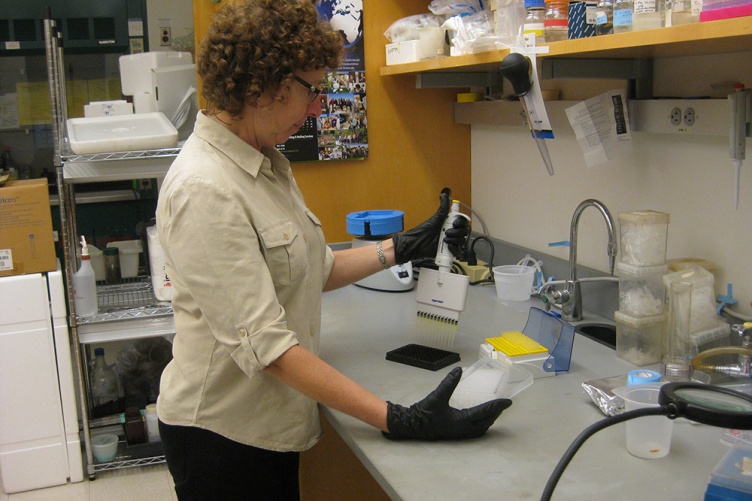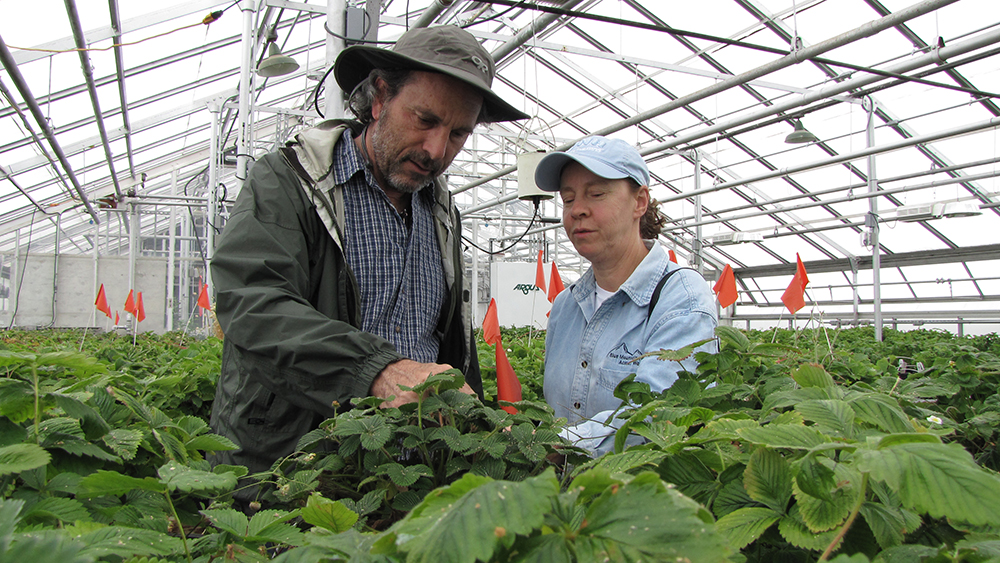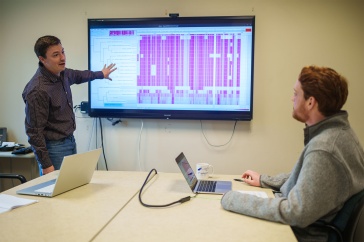
Lise Mahoney, a doctoral student in plant biology, demonstrates how DNA samples of strawberry plants are prepared for analysis.
 Strawberry shortcake. Strawberry rhubarb pie. Strawberry ice cream. Summertime in New England wouldn’t be the same without these bountiful, sweet, juicy berries.
Strawberry shortcake. Strawberry rhubarb pie. Strawberry ice cream. Summertime in New England wouldn’t be the same without these bountiful, sweet, juicy berries.
But not all strawberries are created equal. Some taste better, and are therefore more popular with consumers, while others are more resistant to disease, and thus less costly to growers. At the NH Agriculture Experiment Station at the University of New Hampshire College of Life Sciences and Agriculture (COLSA), scientists have been instrumental in helping breed better strawberries using genetics to determine which strawberries have the best combinations of qualities.
Geneticist Tom Davis and his team of researchers, including bioinformaticist Hailong Zhang, and graduate students Lise Mahoney, David Wood, and Yilong Yang, have played an integral role in developing the IStraw90® SNP Array. The array is a powerful tool that allows strawberry breeders to use the DNA of strawberries to select plants with potentially superior combinations of the genes that influence traits of interest, such as disease resistance and fruit taste. The array, which allows breeders to look at 90,000 different DNA features known as molecular markers, is manufactured by biotechnology company Affymetrix of Santa Clara, Calif., and is the first and most sophisticated tool of its kind for strawberry.
 “With the IStraw90 Array, strawberry breeders are finally positioned to practice marker-assisted breeding, through which breeders will use DNA information on a massive scale to identify superior plants, not just on the basis of their visual characteristics, but on subtle variations in their DNA,” Davis said.
“With the IStraw90 Array, strawberry breeders are finally positioned to practice marker-assisted breeding, through which breeders will use DNA information on a massive scale to identify superior plants, not just on the basis of their visual characteristics, but on subtle variations in their DNA,” Davis said.
The United States is the world’s leading producer of strawberries. In 2012, the United States produced more than 3 billion pounds valued at $2.4 billion, according to the USDA. Most U.S. strawberries are grown in California. Strawberries are an important crop in New Hampshire. Becky Sideman, associate professor of plant biology and UNH Cooperative Extension professor and specialist in sustainable horticulture production, estimates the retail value of New Hampshire’s strawberry crops at about $1.85 million, which she says is a conservative estimate.
Prior to the advent of the marker-assisted approach, breeders had to rely only on the evaluation of traits, while having little or no knowledge of the underlying genetic composition. Yet evaluation of traits can be costly and time-consuming.
For example, if a breeder wants to determine which two of her 1,000 strawberry plants are the most resistance to a certain disease so that she can crossbreed them, Davis explained that the breeder would have to infect each of those plants with the disease organism to see which plants get sick or die, and which remain healthy. This screening process is laborious, and must be performed under carefully controlled conditions, such as in a specifically equipped greenhouse.
 “The reason that a certain plant may be resistant to a disease is because it has a certain form of a gene, which we call an allele. There may be multiple alleles that contribute to that resistance. These DNA tests give us the ability to test the plant by taking just a little piece of leaf tissue to see which plants have these alleles needed to be resistant to a disease,” Davis said. “Thus, the plants can be rated for their capacity to resist a disease without ever exposing them to the disease organism.”
“The reason that a certain plant may be resistant to a disease is because it has a certain form of a gene, which we call an allele. There may be multiple alleles that contribute to that resistance. These DNA tests give us the ability to test the plant by taking just a little piece of leaf tissue to see which plants have these alleles needed to be resistant to a disease,” Davis said. “Thus, the plants can be rated for their capacity to resist a disease without ever exposing them to the disease organism.”
After determining which strawberry plants have the desired alleles, a breeder can then cross-breed them and grow the next generation of her crop. This cycle can be repeated for each generation of strawberry plants – evaluating the diversity of that generation of plants using genetics, crossing, pollinating, and selecting.
“This brings into play economies of scale that didn’t exist before,” Davis said. “Breeders are always trying to find that best plant, yet many different qualities must be evaluated. With the IStraw90 Array, the genes influencing dozens of different traits can be evaluated simultaneously, allowing breeders to more quickly sort through their populations of plants, which saves time and effort.”
The strawberry is among the most genetically complex plants, with eight sets of chromosomes. In comparison, humans have two sets of chromosomes – one set inherited from each parent. Not surprisingly, it has taken scientists longer to develop DNA analysis tools for strawberry than for some other crop plants and domesticated animals. Therefore, design and release of the IStraw90 array is a major achievement.
 Considered among the leading scientists worldwide conducting this kind of research, Davis and scientists in his lab are part of a broad USDA/NIFA-funded international research effort, RosBREED, to develop marker-assisted breeding for a variety of produce that are part of the Rosaceae family, which includes apples, peaches, cherries, and strawberries. The NH Agricultural Experiment Station has played a significant role in funding Davis’s work at UNH.
Considered among the leading scientists worldwide conducting this kind of research, Davis and scientists in his lab are part of a broad USDA/NIFA-funded international research effort, RosBREED, to develop marker-assisted breeding for a variety of produce that are part of the Rosaceae family, which includes apples, peaches, cherries, and strawberries. The NH Agricultural Experiment Station has played a significant role in funding Davis’s work at UNH.
Founded in 1887, the NH Agricultural Experiment Station at theUNH College of Life Sciences and Agriculture is UNH’s original research center and an elemental component of New Hampshire's land-grant university heritage and mission. We steward federal and state funding to provide unbiased and objective research concerning diverse aspects of sustainable agriculture and foods, aquaculture, forest management, and related wildlife, natural resources and rural community topics. We maintain the Woodman and Kingman agronomy and horticultural farms, the Macfarlane Greenhouses, the Fairchild Dairy Teaching and Research Center, and the Organic Dairy Research Farm. Additional properties also provide forage, forests and woodlands in direct support to research, teaching, and outreach.
-
Written By:
Lori Tyler Gula, PhD | NH Agricultural Experiment Station | lori.gula@unh.edu | 603-862-1452

















































